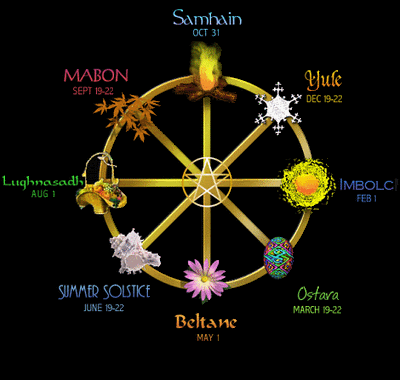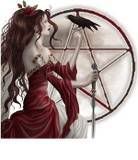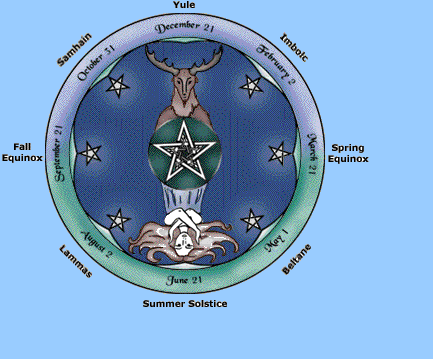|
|
|
|
|
|
|
|
|
 Posted: Sun May 18, 2008 3:26 pm Posted: Sun May 18, 2008 3:26 pm

www.mindspring.com
(the site is no longer working)
Welcome to your Guide on Sabbats. There is much to learn here so I suggest you have notebooks and pens, or perhaps even your BOS ready to take some notes so that you can later refer to this information WITHOUT having to look at the lesson again. Please take a moment to look at the Esbats page as well, though most Esbats are simple it does not hurt to learn all that you can about all that you can. (Esbats are not up yet please be patient)
(A little side note, I will use a lot of information I myself have collected over the years, I am no BOS so I do not memorize all the parts of the Sabbats so yes I am using pre-made information BUT I give credit to anything that I have "copied". However some of it I am unsure about the origin therefore I am unable to give credit EVERYWHERE it is deserved but I will try my best.)
The Sabbats are listed individually in the Acadamy but here are the links to each of those threads:
Samhain:
http://www.gaiaonline.com/guilds/viewtopic.php?page=1&t=12681831#152931936
Yule:
http://www.gaiaonline.com/guilds/viewtopic.php?page=1&t=13536511#163962875
Imbolc:
http://www.gaiaonline.com/guilds/viewtopic.php?page=1&t=13700959#166277184
Ostara
Beltane
Litha
Lammas: Lughnassad
Mabon
~~~~***~~~~
Esbats
Here is a little bonus I put together to help your all out if you need it.
Wiccan Preparations
This Thread will have circle Castings/Invokeing and much much more. Found in the BOS part of this Guild.
Here is the link to the original Sabbats Thread that I made, I will no longer be working on that one but will be expanding this one.
The Sabbats Original
*Please bare with me, it will take some time to get all of these pages finished, it is a lot of work and I am only one person so again please check back often*
|
 |
 |
|
|
|
|
|
|
|
|
|
|
|
|
 Posted: Sun May 18, 2008 3:31 pm Posted: Sun May 18, 2008 3:31 pm

Samhain (sow-en): Witchs' New Year
October 31: A Greater Sabbat
Samhain is the Pagan New Year, and marks the coming of winter. It is more commonly recognized, by non-Pagans, as Halloween. This is a date that is often recognized as a time where the barriers between different planes of existence (our mundane plane and the Otherworld, where the spirits of the departed dwell between lives) are at their thinnest. Pagans generally use this as a time of reflection, in memory of departed loved ones. This Sabbat also marks the symbolic death of the God, who awaits his re-birth with the coming of Yule.
Yule: Winter Solstice
December 19-22 (the date varies yearly): A Lesser Sabbat
Yule is celebrated on the Winter Solstice. It is on this, the shortest day of the year, that the God is symbolically reborn, with the days now beginning to get longer as the Sun grows stronger, symbolizing the reborn God now growing. The sun was often recognized as the symbol of the God, in ancient religions. Most Pagans believe in reincarnation, sure in their knowledge that they will be reborn again (as the Sun God is Reborn each Yule) to experience new lessons. Traditional activities include the Yule Tree, Yule Log and the giving and receiving of gifts.
Imbolc: (im-bolk): Candlemas
February 1: A Greater Sabbat
Imbolc (also known as Candlemas) is a celebration of fertility, inspiration and purification, and marks the beginning of Springtime. It symbolizes the awakening of life deep within the earth, although that life is not yet visible. The God is beginning to grow, and his strength (visible in the power of the Sun) is beginning to be noticeable with the continued lengthening of the days. It is traditional at Candlemas to light every lamp in the house for a few minutes in honour of the Sun's rebirth.
Ostara (oh-star-ah): Spring Equinox
March 19-22 (the date varies yearly): A Lesser Sabbat
Ostara (also known as Eostara) occurs on the Spring Equinox, and is considered the first day of true spring. The day and night are equal in length, and the Plants are beginning to bud and sprout. Some ancient Pagan traditions are still practiced on this day, such as colouring eggs (which are a symbol of fertility), collecting wildflowers, walking in nature's beauty and cultivating herb gardens. This is the time to free yourself from anything in the past that is holding you back.
Beltane (bel-tayne): Mayday
May 1: A Greater Sabbat
Beltane is commonly recognized as May Day (the start of Summer), by non-Pagans. It is a celebration of love and desire, symbolizing the Union of the God and Goddess, which honours the fertility of the Earth. Many flowers and plants are often gathered, as decorations, the flowers being symbolic of the Goddess. Celebrations include weaving a web of life around the "May Poles" which were often erected (and sometimes still are), as a symbol of the God (an obvious fertility symbol, some consider Phallic in aspect), and leaping the Beltane fire for luck. Beltane is a choice day for many Pagans to get 'Handfasted' (Pagan Marriage). This is a time of self-discovery, love, union and developing your potential for personal growth.
Litha Sumer Solstice
June 19-22 (the date varies yearly): A Lesser Sabbat
Litha (also known as Midsummer), which is celebrated on the Summer Solstice, is the time of year when nature is at it's peak strength, The God at the Peak of his power, the days being at their longest. This is a time when many Pagans feel it is best for rituals and spells. Bonfires are often made, to symbolize and honour the God.
Lammas: Lughnassadh (loo-nus-uh)
Aug 1 Lamas A Greater Sabbat
Lammas (also known as Lughnasadh) is the first Harvest Festival, observed during the beginning of harvest, at the start of Autumn. Pagans are thankful for the food with which they have been blessed. Plants are withering, but they are also leaving seeds, a promise of their eventual re-birth. The God is beginning to weaken and dim with age, as the days grow shorter, giving his energy his energy to the crops to ensure life while the Mother prepares to give way to her aspect as the Crone. Now is the time to teach what you have learned, to share the fruits of your achievements with the world. Wheat weaving, such as the making of corn dollies, is traditional. Bread is baked and the altar is decorated with fruits and vegetables of the harvest.
Mabon (may-bon): Autumn Equinox
Sept 19-22 (the date varies yearly): A Lesser Sabbat
Mabon (also known as the Autumn Equinox, or Alban Elfed) is the Second Harvest Festival, observed at the end of harvest. The day and night are once again equal in length, another time of balance, but light is giving way to increased darkness. The God is quickly losing strength, and is preparing for his end, and the Goddess is mourning her fallen consort, but the emphasis is on the message of rebirth that can be found in the harvest seeds.. Summer is over, and Winter is quickly approaching. It is a good time to walk the forests, gathering dried plants for use as altar decorations or herbal magick. Cornbread and cider are good additions to festivities and fall leaves make good altar decorations.http://homepage.ntlworld.com/spiritwolf/wheel_of_the_year.htm
Some of the info was found on this site, and some was from my own BOS
(site no longer works)
The Sabbats that are between dates are those for - 1st day of summer, 1st day of autumn, 1st day of spring, 1st day of winter on the calander for the year.
(the dates are uncertain, there are SO many dates online that I just picked an assumption time period based on what I found)
|
 |
 |
|
|
|
|
|
|
|
|
|
|
|
|
|
|
|
 Posted: Sun May 18, 2008 3:33 pm Posted: Sun May 18, 2008 3:33 pm
Wiccans like to celebrate. The Wiccan calendar contains 13 full moons (Esbats) and 8 Sabbats, or days of power, making 21 Wiccan ritual occasions.
The Esbats are for celebrating the Goddess. The Sabbats mark the sun's yearly cycle and tell the story of The Wheel of the Year.http://www.bewitchingways.com/wicca/year.htm
|
 |
 |
|
|
|
|
|
|
|
|
|
|
|
|
 Posted: Sun May 18, 2008 3:37 pm Posted: Sun May 18, 2008 3:37 pm
Moon Information ~Many faiths/lore and people say that when there is Blood on the Moon that it means some has/will die that night...I am not sure if it is true but I personally think that is creepy. So next time you see a moon that is red "Blood on the Moon" contemplate this theory.
~Once in a blue moon can actually happen, and here is how. Usually each month in the year has one full moon, well on rare occasions there will be a second full moon during a certain month due to some reason that even I do not know lol. Anyways the term Blue Moon refers to the second full moon that may fall in one single month.
The Blue Moon http://realmagick.com/articles/29/1029.html
This is the second Full Moon which falls within in a single month, it varies each year. When the Blue Moon occurs plan to do something strange, something you have never done before. Write letters to folks you have not seen for years, plan a surprise for someone you love. Howl at the Moon!
Full Moon Names: Courtesy of:
http://realmagick.com/articles/29/1029.html
Now we all know there are different full moon names, farmers would have different names and those can be found here:
http://www.farmersalmanac.com/astronomy/fullmoonnames.html
Many of the ideas and names are the same, but some are different.
January, The Wolf Moon
The first full moon is a time of silence and sitting by the home fire. As the wild winter howls, appreciate the warmth of home and family. Now is the time to go within and plan the changes you will make in the spring. Consider now what you will plant. Start a moon journal to record your lunar tides and write down your spring dreams.
February, The Storm Moon
At this Moon begin your spring cleaning. Think about what needs to be released and let go of in your life and in your home. Burn white candles and purifying incense, sweep out the cobwebs and prepare for the new growth of spring.
March, The Chaste Moon
This is the Moon of the maiden and Faery folk. Gather the seeds of inspiration and imagine what they can grow into. Build an Altar to the Moon and bless your garden in the moonlight. Prepare the earth for planting and yourself for change.
April, The Seed Moon
At the Seed Moon plant your seeds of magick, whether it be in a garden, in a pot by the window or simply in your heart. Fill your home with light and flowers, create colorful eggs to decorate it and bring fertility and joy. On the full Moon plant herbs. Sing in the rain...
May, The Hare Moon
Now is the time to celebrate life and love. Renew and affirm your sensuality, kindle the fire of romance . Dance and make love by the light of a bon fire, the glow of red candles, or just the full moons radiance. Free your wild nature....
June, The Dyad Moon
See how things are growing! The old has died away to make room for the new . Create an Altar of roses and honor the beauty of nature. Send flowers to your mother. Hike to the top of a mountain...
July, The Mead Moon
Bask in the warmth of summer and take time for yourself, relax. Perhaps a moonlit walk by the sea to gather sacred seashells. Make an ocean amulet necklace for one you love.
August, The Corn Moon
This is a time to harvest the gifts you have nurtured and give to those who are in need. Collect and store fresh herbs for the coming winter. Bake special breads to honor the God and Goddess of grain and growing things, share them with your family and friends but save some to offer the Earth.
September, The Harvest Moon
Drink a toast to Dionysus, the God of wine and ecstasy - The son of the Moon! Gather with friends to celebrate the vine with a bottle of good wine and good cheer. Catch the Moons reflection in your cup and raise it up in salutation, now drink in her essence and feel the presence of the God and Goddess.
October, The Blood Moon
In the past this was the time of hunting and storing. The wheel of the year turns like the cycle of life and death. At this Moon the veil is thin, make an Altar to honor your ancestors and ask them to guide and protect you. Carve pumpkins and place candles within to light their way.
November, The Snow Moon
Winter's cold descends and outward growth slows. Make this a time for inner growth. Learn a new craft or study thwarts of divination. When the Moon is full do a reading for yourself or your friends. Develop your psychic talents.
December, The Oak Moon
The time of the Suns return approaches and the Moon awaits her lover. Make wreaths of Holly, Pine, Oak, Cedar or Ivy. On the full Oak Moon burn them as an offering to the Sun and Moon. Create a sacred Moon ornament to hang on the boughs of your yule tree.
|
 |
 |
|
|
|
|
|
|
|
|
|
 |
|
|
|
|
|
|






